San Blas, Panama
Part One: Corrientes Fáciles (Easy Currents)
San Blas Islands, Gunayala Region, Panama Expediciones Tropicales; February 29, 2020 – March 5, 2020.
Day One – Within a nautical mile we were soaked with warm Caribbean spray as we departed the busy Port of Barsuggum, bouncing fast over two-foot white caps into a fresh wind. Glancing over my shoulder and opening my eyes, I spied through the spray a sole native skipper steering twin 75hp Evinrudes at full speed, one in each hand. Amazing we were finally here. Turning to face the bow, I closed my eyes to shield against the spray. I had no idea to what degree of the compass rose we were heading.
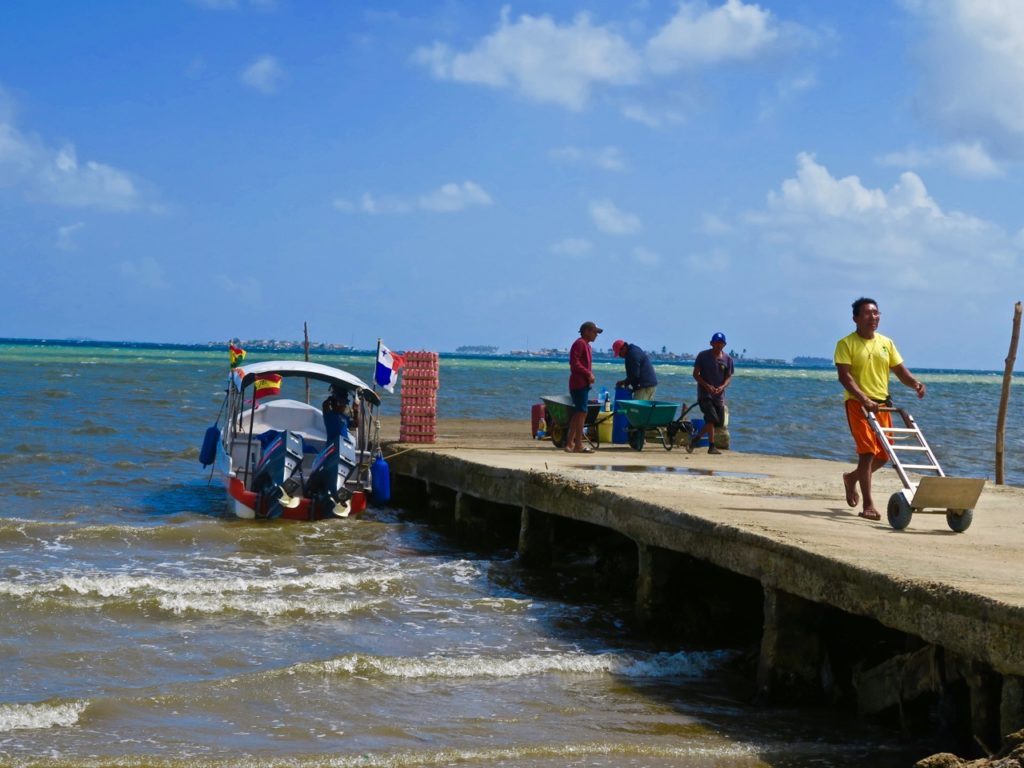
Tabitha and I met Ilene Price in Valdez nearly a decade ago when she was a kayak guide in the chilly waters of Prince William Sound. We asked her to join us as the swimmer on our triathlon team, which we subsequently won! So it should come as no surprise that we would trust her as our guide for four days of paddling the San Blas Islands. Her vast experience, including a decade of guiding in Alaska and pioneering commercial kayaking in remote Panama, helped seal our decision to head to Panama. Ilene has gained the respect of the region’s indigenous Kuna people and she has learned the language and culture as few non-residents have. While my skills as a ski guide are handy in our travels, this was different beast for sure. Ilene’s Spanish is very good, so she ably translated our constant barrage of questions for Nemesio and his answers back to us.
Along with Ilene, our crew consisted of fifty-year-old native-Kuna guide, Nemesio, who has paddled his local waters for decades and with whom Ilene has partnered up for many trips, a cook, and two Kuna boat operators. The small boat, loaded with supplies, was powered by a two 15hp Evinrude, and was ahead of us dropping off the kayaks at our first camp. The boat provided support and versatility (and a margin of safety) as we island-hopped in our kayaks. The logistics were obviously complicated, but, nonetheless, the trip progressed smoothly.
After two hours bouncing by breakers and reefs, we finally grounded the boat on the small Island of Bebbsidup. With palm trees waving about the white sands, two young native boys popped out of a palm hut and shyly observed us. Their mother and grandmother, wearing beautiful native attire, greeted us with warm smiles. Within an hour, our tents were set and we began taking in the vast seascape with no one else in sight.
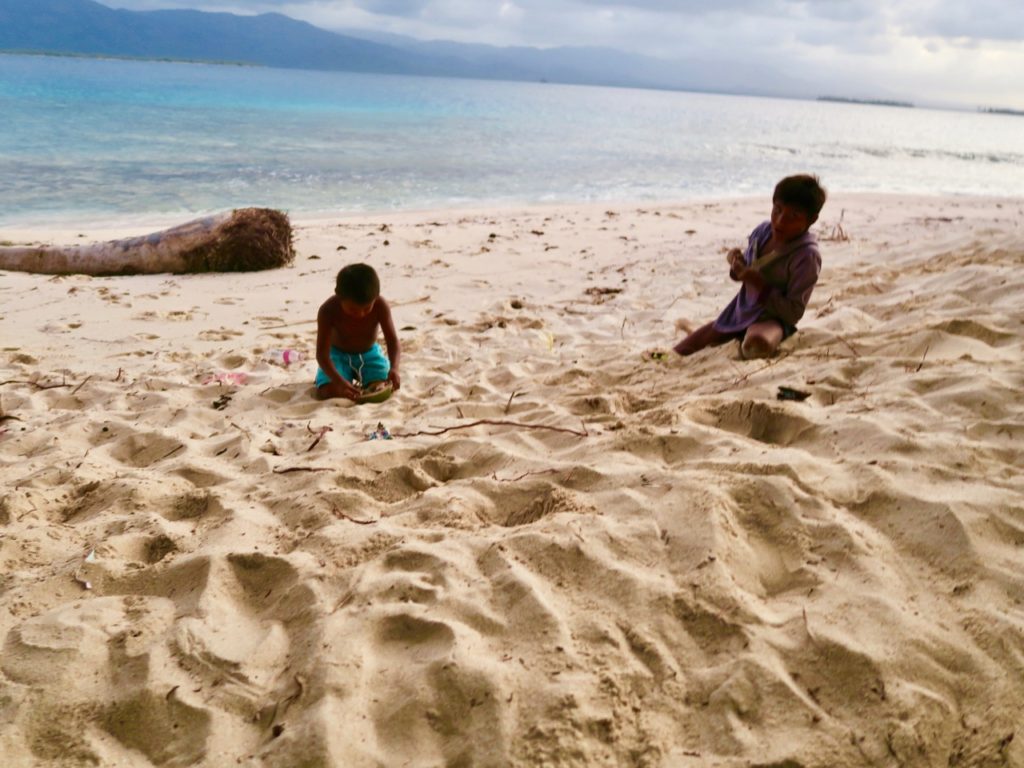
The sea’s state looked rough, so we lounged the afternoon and waded white sand, “acclimated”, and interacted with the four residents from the Kuna village barely visible on the mainline to the south. They had been on the Island for months and in a few days planned to head back to the mainline for school. Their family owns the island and hosts small groups from time to time. They move back to the mainland for the monsoon season. Fish, coconuts, and crabs are abundant as is time to make intricate cloth molas and beaded leggings. Water is critical, and it is delivered by skiff in twenty-gallon jugs, harvested from a river near the village on the mainland.
The major safety concern of living on the island is falling coconuts and palm branches. I heard objects drop with thuds onto the soft sands. Sand flies must be brutal, but we were lucky and were never forced to retreat to our tents to escape them. Before dinner one evening, the wind calmed and the look on everyone’s faces showed sudden concern about the flies, but the wind came back and everyone seemed relieved. We got a few minor bites, but never had an issue with bugs. We were even able to leave the tent door open all night and enjoy the breeze.
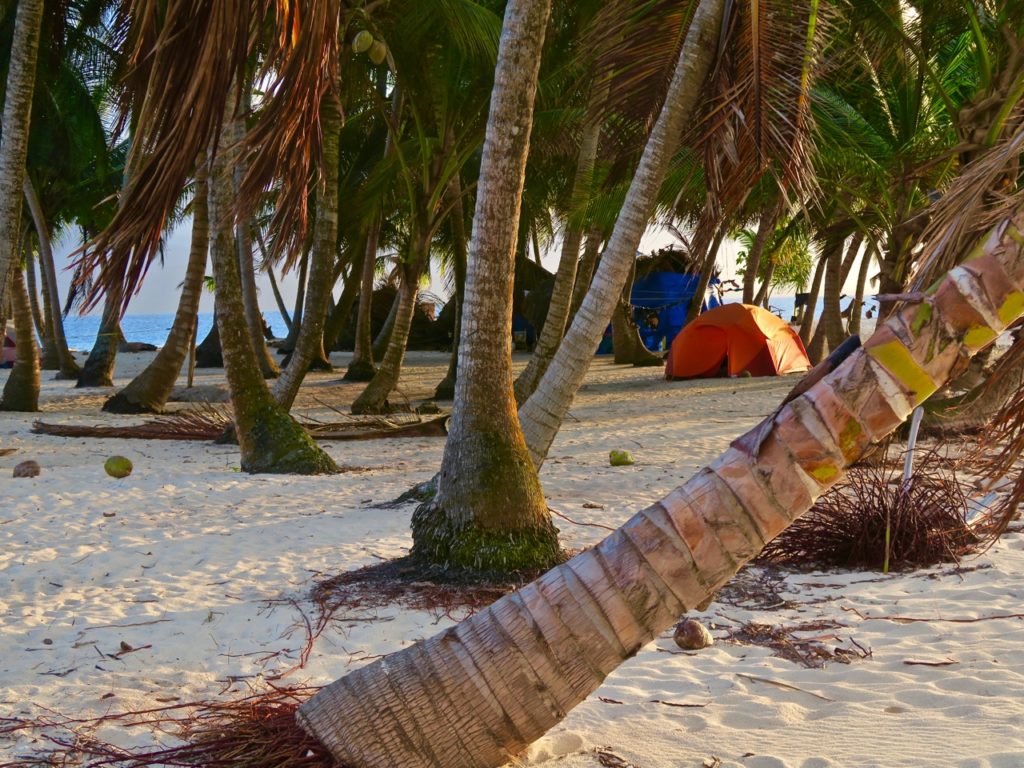
Ilene familiarized us with the kayaks and paddling techniques as the sun set. Meanwhile the little boys played with hand-made coconut-shell boats and toy men that had washed up on the beach, and built tiny forts out of beach debris.
Our cook was busy with fresh seafood and the grandmother chopped coconut with a machete for milk and nut with a wicked accuracy and swing. We finally settled into our first of many outstanding meals and lined out our plans for the first day in the kayaks and getting acquainted with the team, none of whom spoke English, except Nemesio. The natives teased as we ate salad, saying we ate “like cows” to which we responded “moo”. They were surprised when we ate any fish they did!
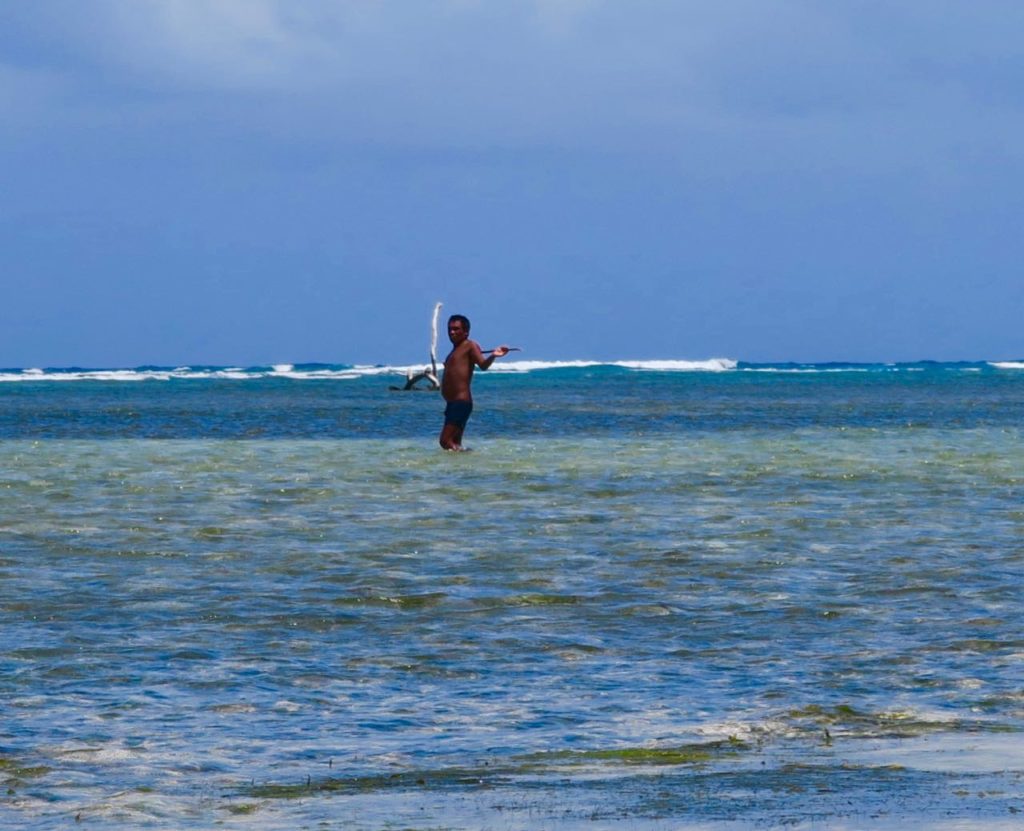
DAY TWO- Tabitha and I have little, if any, experience in kayaks. I did some cold water kayak training to prep for the Ski-To-Sea race in Valdez long ago, but frankly I did not have a desire to do this in cold water. Ilene and Nemesio quickly put us at ease after we shoved away from our little Eden. Heading out to sea over clear blue waters, small whitecaps quickly lost their menacing look from shore. Hues of blue dotted the ocean’s surface all around us while the sea bed rose and fell in an ever-ending array of browns and golds.
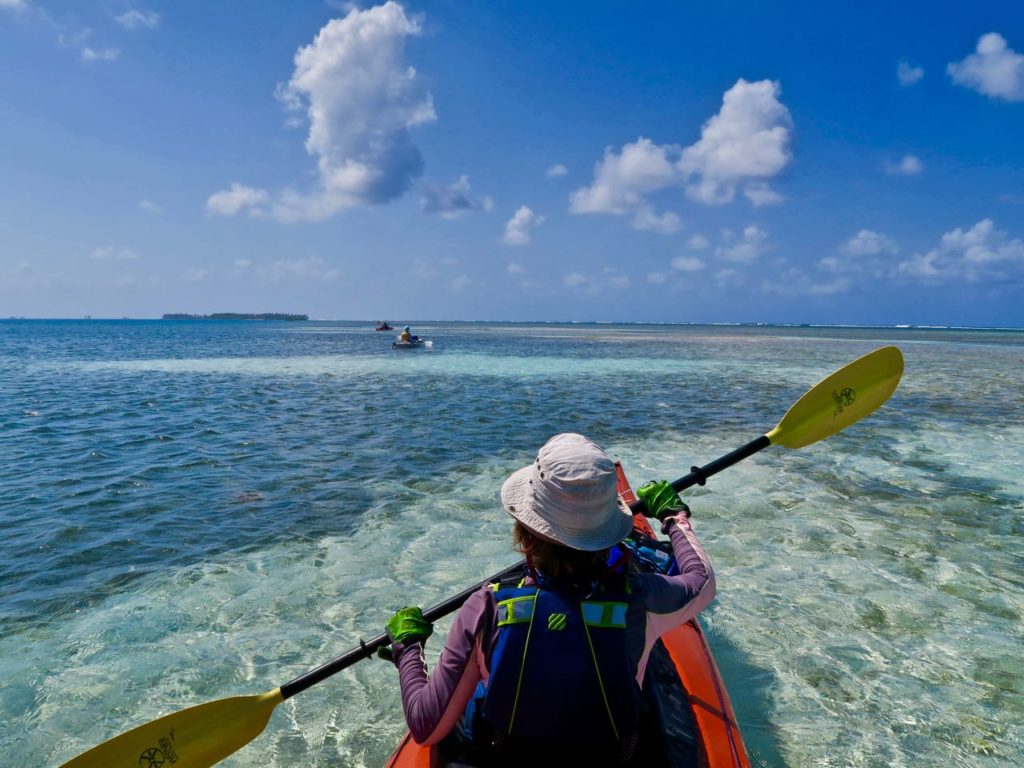
The distances looked overwhelming, but Tabitha and I quickly found a rhythm in the double-kayak, with me in the back working the rudder. We wore long sleeve shirts and white hats while our white legs hid from the sun under the kayak’s shell and spray skirt. The skyline was dotted with small islands, some with sandy white beaches and others surrounded by an impenetrable web of mangroves. Here, as opposed to Alaska, a slip into the water would be refreshing and funny versus a life threatening emergency. The tropical winds were warm and the sky was patched with clouds and distant warm rains.
After taking a short break for some excellent snorkeling we headed to the coast crossing a wide channel for an amazing paddle up a remote river. Breaching the rainforest of the mainland, the waters turned shallow, clear and warmer. The jungle quickly moved in to trap us and birds sang and swooped about. Birding is very challenging anywhere, but more so here as species are abundant with colors to rival the brightest rainbow. I focused on taking digital zoom pictures for late identification and Ilene and Nemesio were familiar with most the species we encountered.
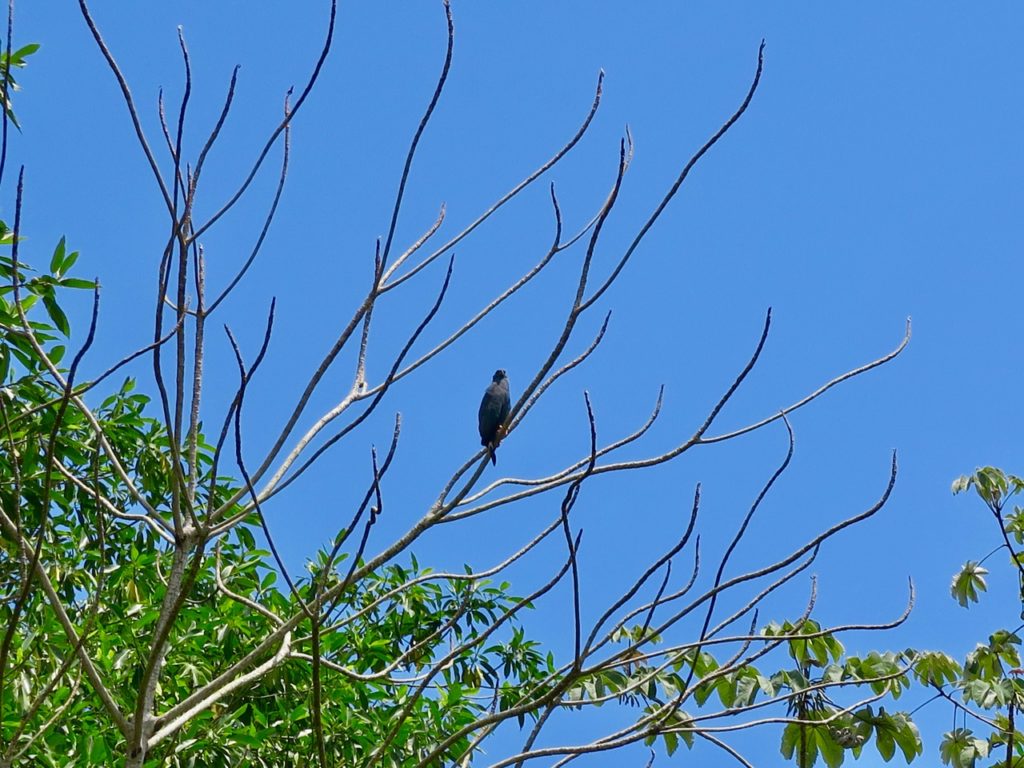
We grounded the kayaks, then waded up stream for a few hours. Again, you can’t do this in the chilly waters of Alaska. At times I felt like that young boy wondering Joe Creek in Tulsa when it was wild with snakes and frogs.
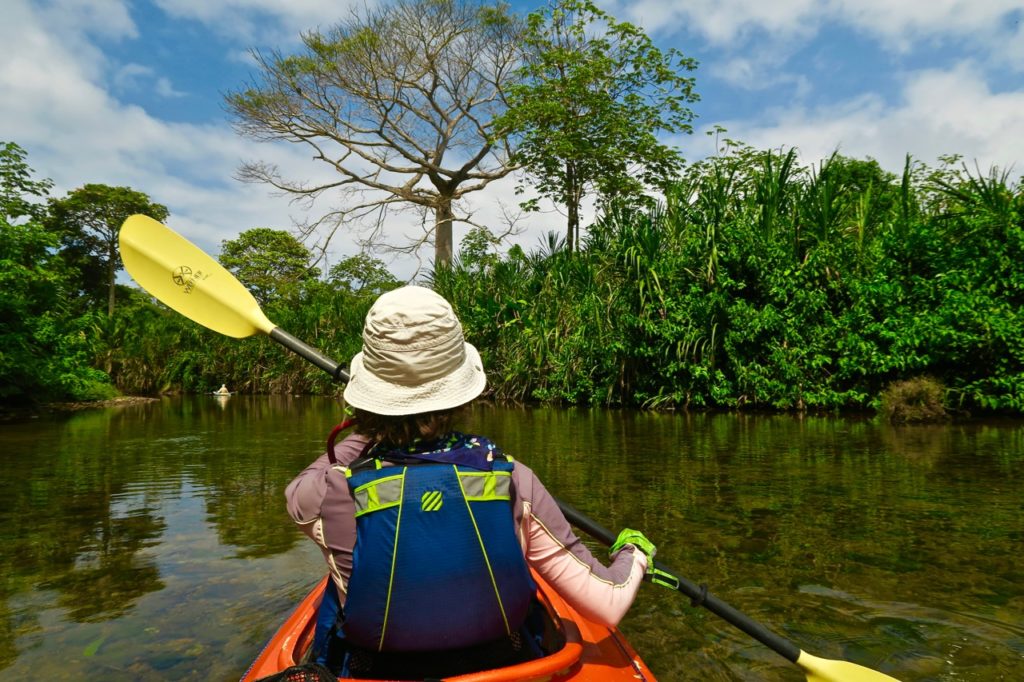
Eventually the river rocks grew in size and the channel narrowed, so we returned to our kayaks for lunch.
We rounded a corner and found our boat crew, cook, and the island family frolicking in the warm, fresh water and preparing lunch. Grandmother had also come along and seemed overjoyed to be in her space, her lands with her family. A perfect swimming hole at our beach allowed a refreshing cleanse before we headed back to the sands and salt of our camp.
We exited the river on a small sand bar. Our camp was a bit too far of an effort so we loaded up everything – families, kayaks, and gear into the 18’ boat and motored to our island at 5mph watching the horizon for a small button of palm trees waving at us to come home safely.
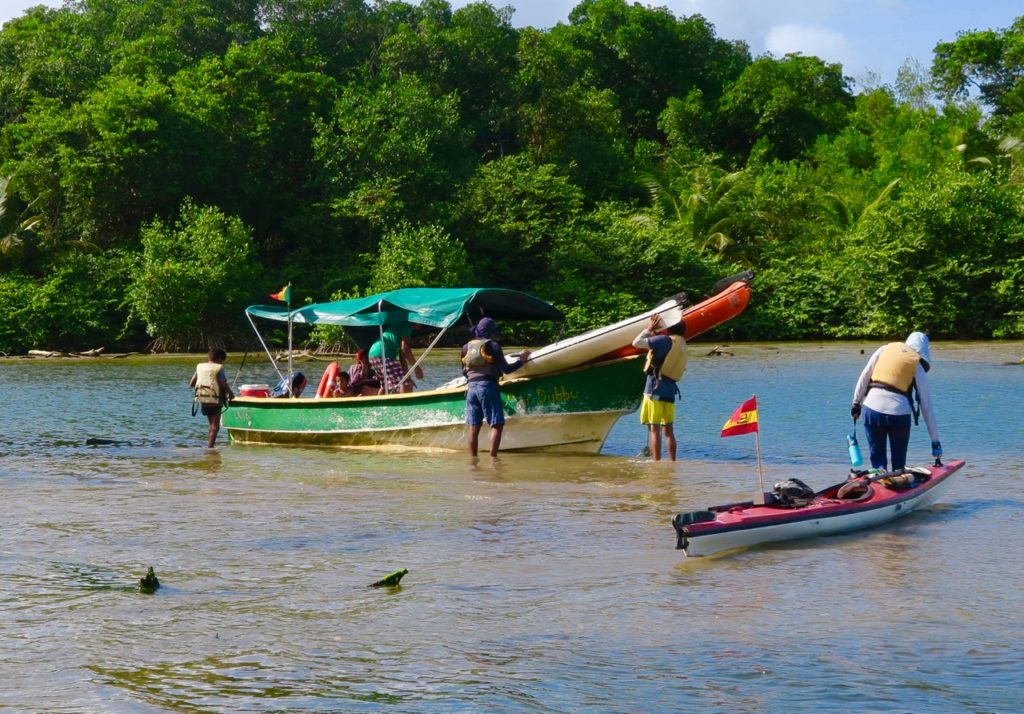
Once back at camp we compared field notes with a resource of books that Ilene brought. As with most serious birders we debated this mark or that mark, color, size, and morphology. Eventually we would arrive at an agreement of which one of the 600 species of birds it could be.
DAY 3
Breakfast was perfect every morning. Local fruit and a variety of tasty “hot” vegetarian choices had me eating breakfast, a meal I typically skip. Camp was broken down and after two delightful days slowly immersing ourselves in the culture of the Kuna, we pushed off toward the west.
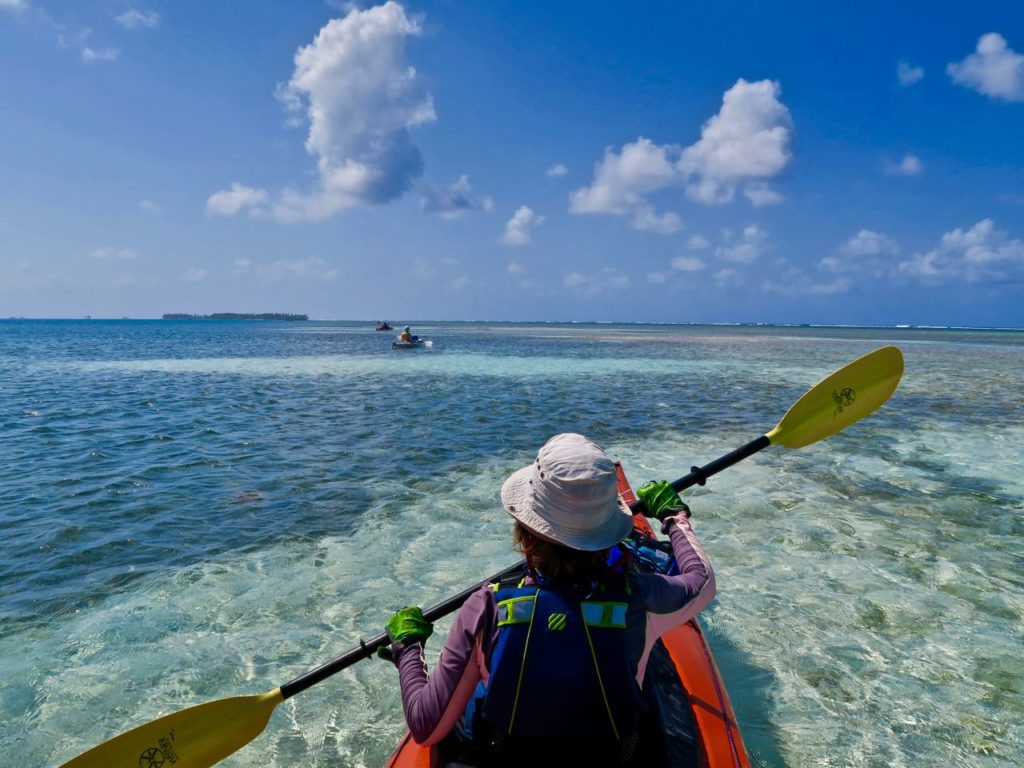
Crossing another channel, weaving through reefs, new islands popped up here and there. A few clusters of ocean sailors lay at anchor in classic romantic locations. Paddling along islands choked by mangroves our guides kept us on the leeside of islands and we found it easier paddling and greater distance. We came to enjoy the constant breeze as it kept us cool during the day and the bugs at bay in the evenings.
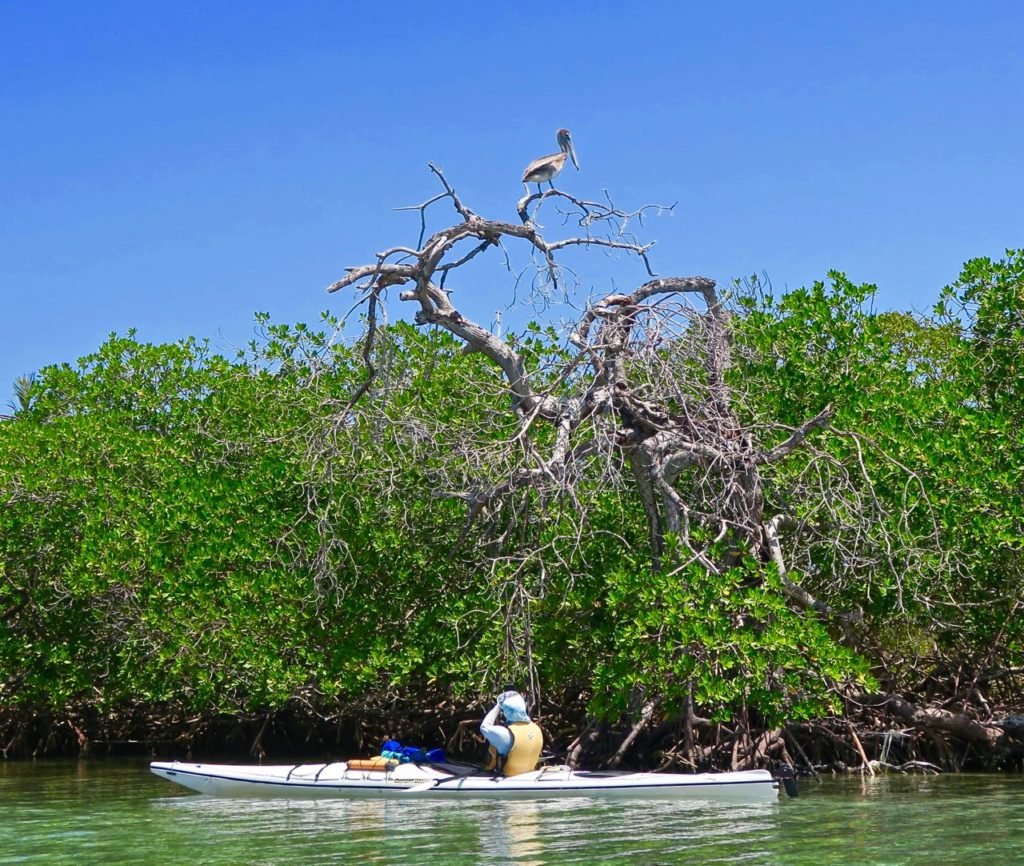
We paddled up to our new campsite and pulled the kayaks onto the beach of Estrellita Island. A few folks from a sailboat poked about the shoreline and huts of the owner and we poked each other about this and that. The owner of the island, Larry, is thirty-something and his grandfather owned the island before him. He lives on the island for six months of the year and subsists off the sea, with fresh water from nearby rivers and other supplies delivered in small skiffs. Families on shore support their families on their islands. Larry and his cohort, Fidel, live in a simple shelter built of palms and he hopes to build a frame “cabana” for guests in the future. Visitors must secure permission to camp on any island in Gunayala and pay a fee. Other than the land owner and Fidel, our small group had the island to ourselves and quickly set up out tents.
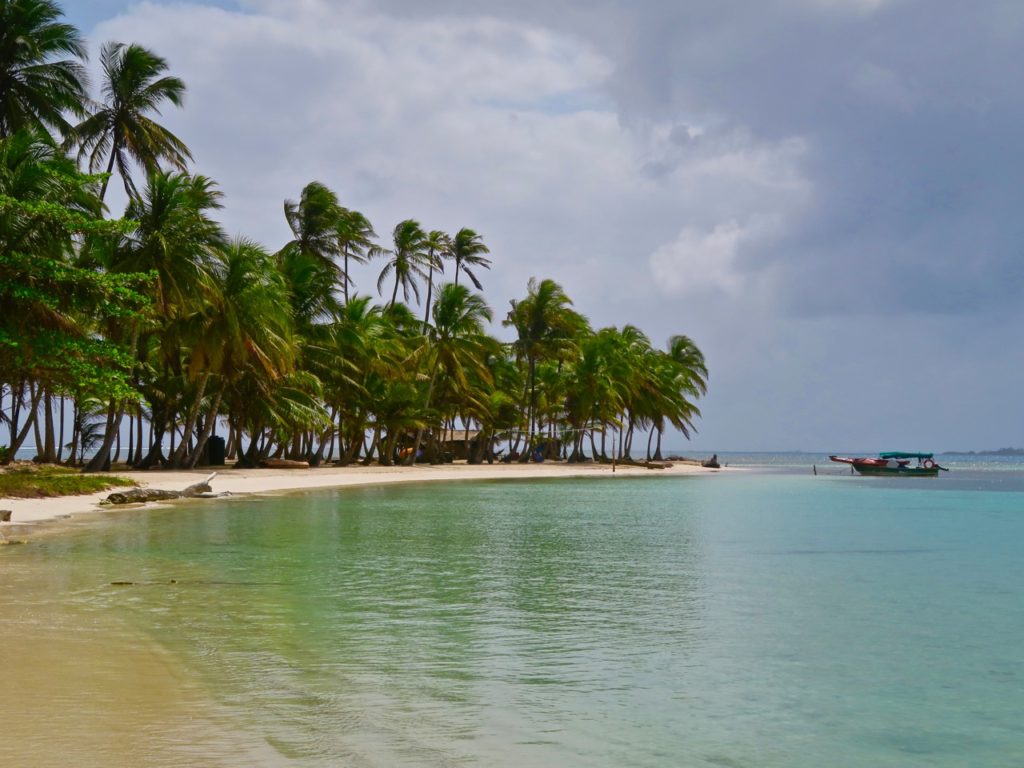
Dinner: I love fish and delighted in it nightly. Every evening we were presented with exotic reef fish I had never heard of, but that tasted better than any fish I’ve ever eaten. Fried boxfish was the best, more so because I watched the guy spear it right off the spit. Along with cooked plantains and coconut rice prepared from fruits of the trees under which we ate …well, you get my point. Every meal was outstanding.
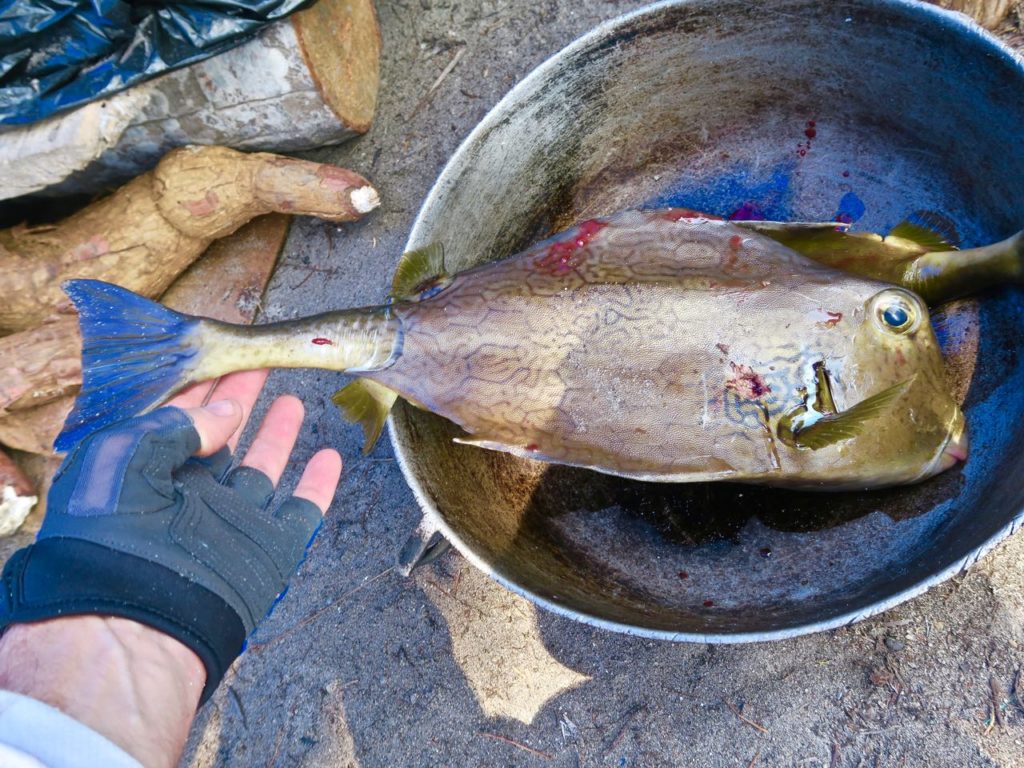
DAY 4
We were shuttled by our small boat a few miles to another small island occupied by a large family with a larger palm shelters surrounded by a reef. We spent the morning exploring the island and then dove into clear waters to probe a small reef. This was our second snorkel and it was amazing. While Tabitha and I had snorkeled many times in Hawaii, the coral our guides showed us were more colorful and healthy. It was cool to see a twenty foot “tree” growing under water along with huge coral clusters. Fish were plentiful and sharks were not an issue in the Caribbean.
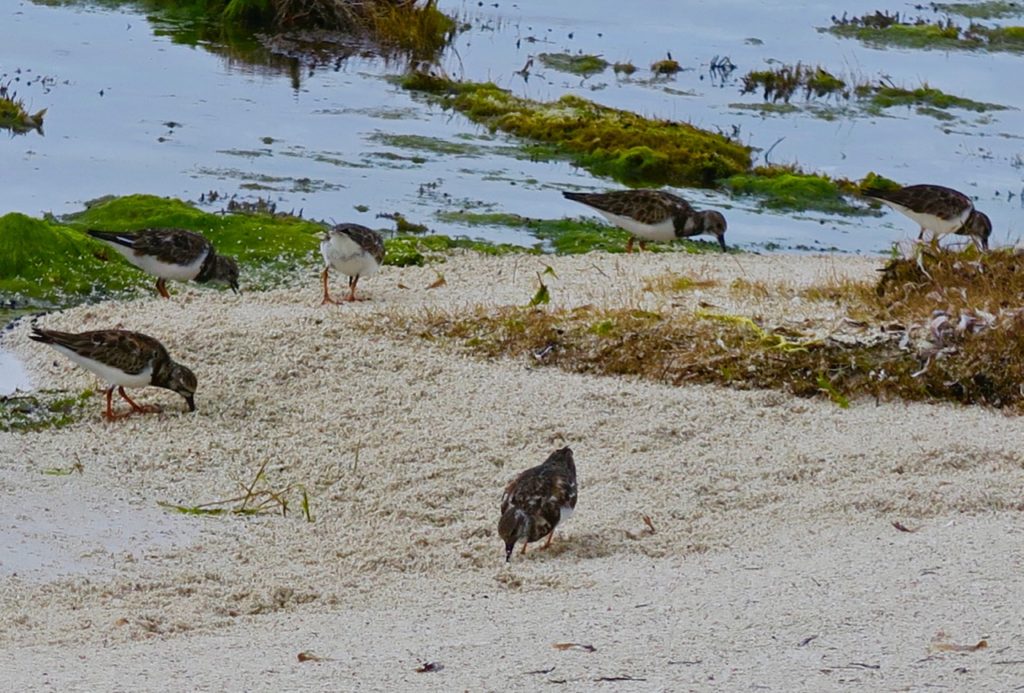
After lunch we settled into our kayak again. I had asked Nemesio if we could head to the large breakers in the distance before continuing along our route and he enthusiastically pointed us toward the surf. The waters progressively got bumpier and we drew as close as possible before swinging our bows around and maneuvering the other way. At one point, in the middle of a channel, I exited the kayak and stood on a large submerged island of sand and pulled the kayak along in knee-deep waters. Just wow.
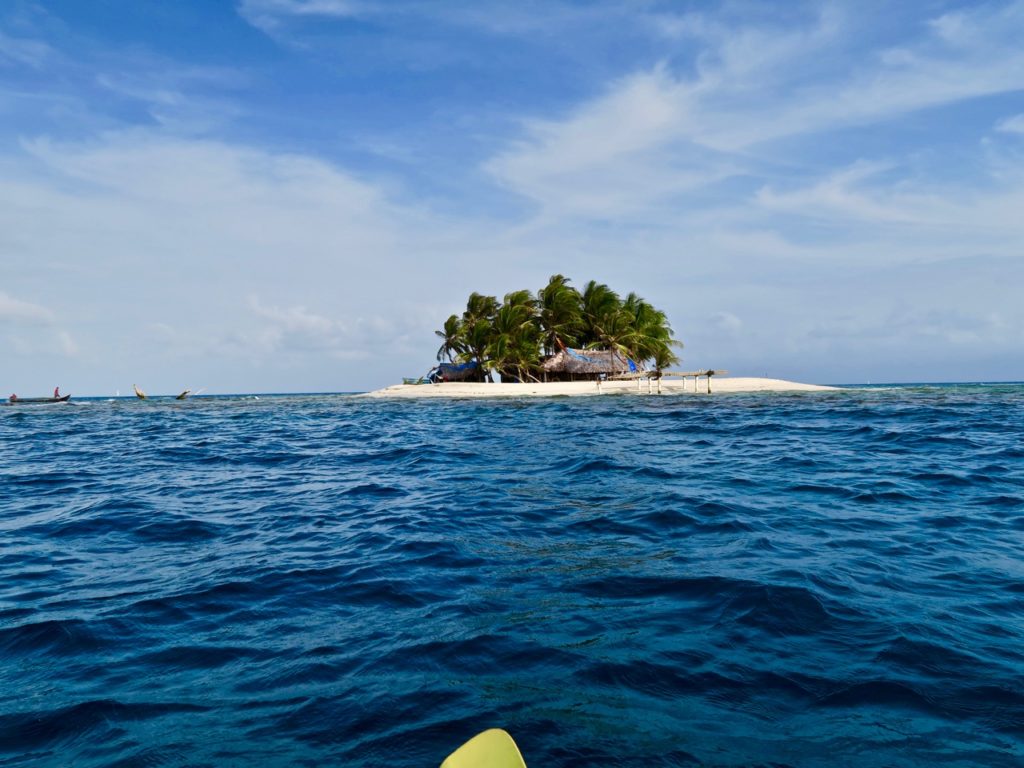
It had been a long day on and in the water. We approached our last camp on yet another isleta. This button of sand was surrounded by a reef that took skill to get through and was slightly more developed with simple frame structures including a large covered shelter to host large groups for lunch. It had flushable toilets, a small generator, and the smallest “bar” I’ve seen. Other natives arrived on small boats as the sun set, welcomed by the island’s caretaker to spend the night before traveling further the next day.
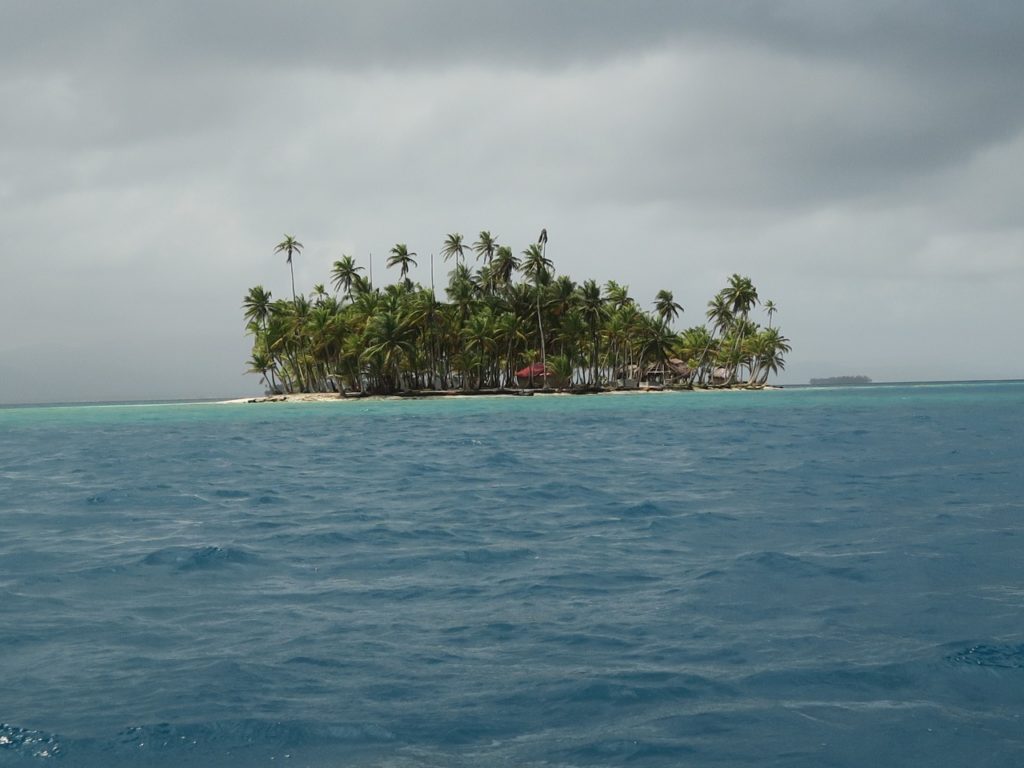
We woke early the next day and hopped into our support boat and puttered our way back to the port for a shuttle back to Panama City.
We passed a few more boats and islands with hardened, yet basic cabins. The “development” still seemed primitive as far as tourism goes. Where I could have envisioned large scale development and fancy resorts, nothing like that that existed. The Kuna people are controlling access and it does not appear that jet skis will arrive here any time soon. Even kite surfing is banned. The Kuna are succeeding in protecting their territory, yet other challenge are rising up…
Next: Part 2 – La Crisis Climática (The Climate Crisis) – Gunyala
